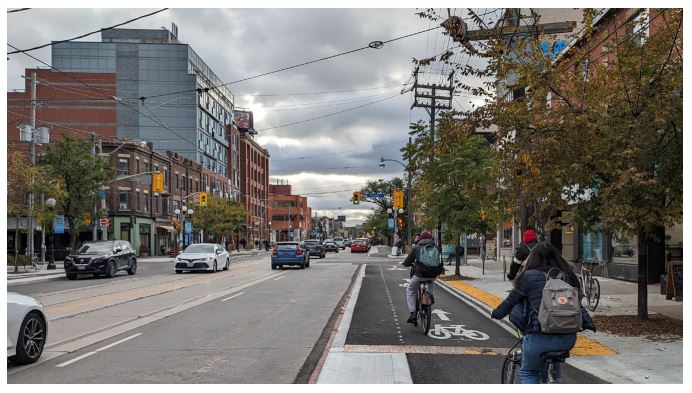The City of Toronto: “$48 million to remove three bike lanes”. Building them had cost $ 27 million
TORONTO – The removal of three (3) cycle lanes in Toronto “will cost at least 48 million dollars”: this is stated in a City of Toronto report published on Wednesday (you can read it here), after the Ontario government introduced – on October 21st – a legislation to remove the bike lanes on Bloor Street, University Avenue and Yonge Street (for a total of 20.2 kilometres: the bike lanes in Toronto cover a total of 270 .9 kilometers of roads, according to the network status of the Municipality, updated on 2022). An elimination necessary, according to the Ontario Ministry of Transportation, to at least partially eliminate traffic jams in the city.
“The removal of existing bike lanes will be a complex project that will be challenging to implement within a short-time period, due to planning, design and construction requirements” reads the report: according to it, the removal of those three lanes will first of all mean a “lost investment of $27 million in city costs to install the existing infrastructure”, and then the removal will imply “as yet unknown additional costs to identify, design, and construct alternative cycling routes, each with their own impacts and infrastructure challenges” and “as yet unknown additional staff resources and infrastructure costs to redesign and reconstruct these roads to add space for motor vehicles”. However, the costs would be around 48 million dollars to eliminate around twenty kilometers of runways, which took 27 million to build. According to the report, therefore, eliminating them would cost almost double what it cost to make them. Or maybe more. At least 48 million, says the Municipality.
According to the City, the elimination of the three cycle lanes would also have other negative impacts on Toronto, including “increased travel times for drivers due to traffic congestion from additional construction that would be necessary to facilitate the removal of existing bike lanes. According to the report, in fact, the three streets where the cycle paths are located should also be “remade”. “Restoring vehicle lanes on Bloor Street, University Avenue and Yonge Street would take additional staff resources and time to redesign and reconstruct these roads, and would negatively impact driver travel time and businesses during construction, with likely minimal improvements in travel time once lanes are removed”, reads the report.
Their removal, also, would limit the City’s ability to reach the “TransformTO” strategy goal of net zero emissions in Toronto by 2040, as well as increasing unsafety for cyclists on the streets: 28 cyclists have died in Toronto from 2015 to today, and 380 people were seriously injured; 68% of accidents occurred on roads without cycle infrastructure. The City’s report also references a study by Toronto Metropolitan University that examined collisions between cyclists and vehicles before and after the City installed fully separated bike lanes between 2000 and 2016: the study found that there were it was a 35% drop in collision rate after installing bike lanes.
Mayor Olivia Chow also spoke on the issue: according to her, “ripping up our roads will make congestion worse, especially during the time that you are ripping it up. It’s costly and it will make our roads less safe for cyclists. And at this point, the province’s plan is arbitrary because they need to look at our numbers”, said Toronto’s Mayor.
But the Province has a completely different opinion and vision. On Wednesday, Dakota Brasier, spokesperson for Ontario Transportation Minister Prabmeet Sarkaria, said bike lanes contribute to traffic jams. “As we have said many times, 1% of people should not be making decisions for the majority of people who travel on our busiest roads and sit in traffic jams every day” Brasier said. “Toronto is one of the economic engines of this country, but we are losing more than $11 billion every year due to traffic jams and congestion. Bike lanes should only go where they make sense. It’s clear the City’s approach isn’t working …” Braiser said.
Minister Sarkaria had previously said that only around 1% of people in the city get around by bike but despite this, “Ontario cities have seen an explosion of bike lanes, including many installed during the pandemic, when fewer vehicles were circulating and their impact on traffic was unclear” Sarkaria said. “As a result, too many drivers are now stuck in traffic jams, which is why our government is pursuing bike lane oversight”.
The question at this point is: at any cost?
In the pic above, a bike lane in Toronto (photo: City of Toronto, 2023-Toronto-Cycling-Year-in-Review); here below, the cartoon by Ynot (Corriere Canadese)




